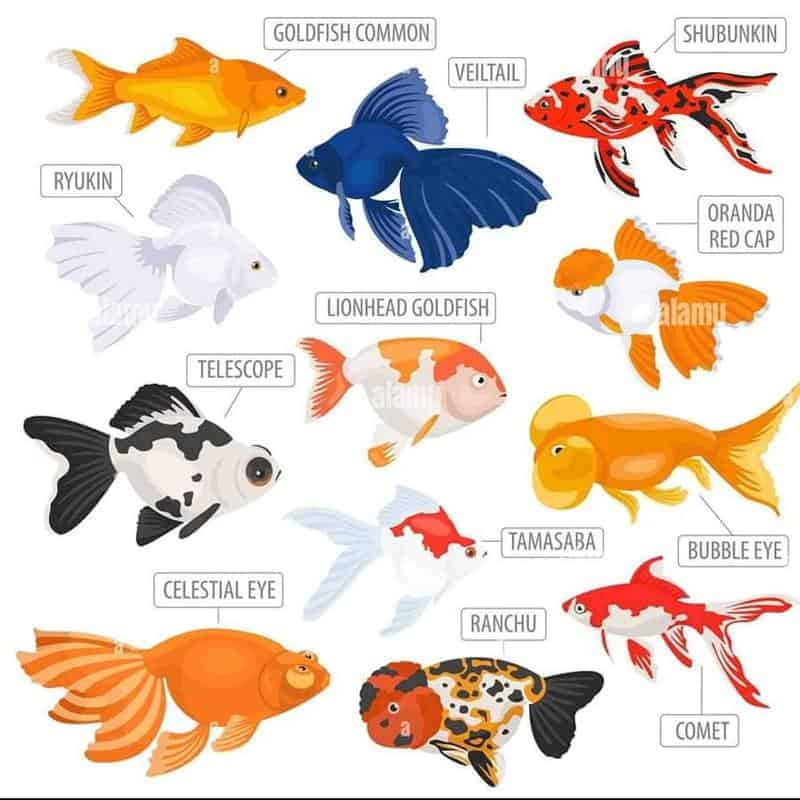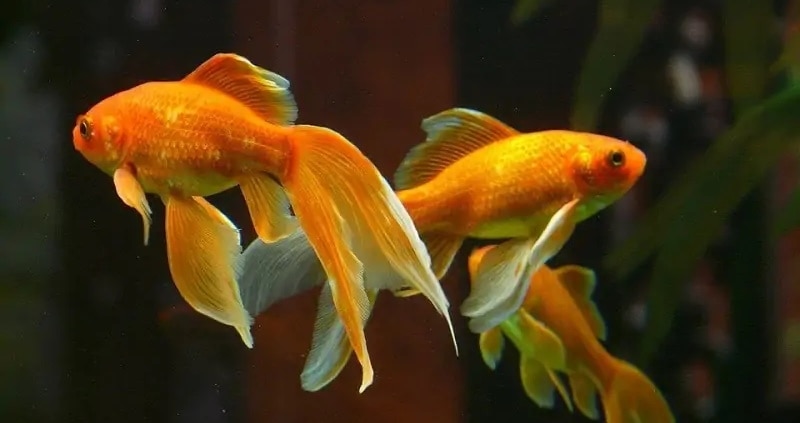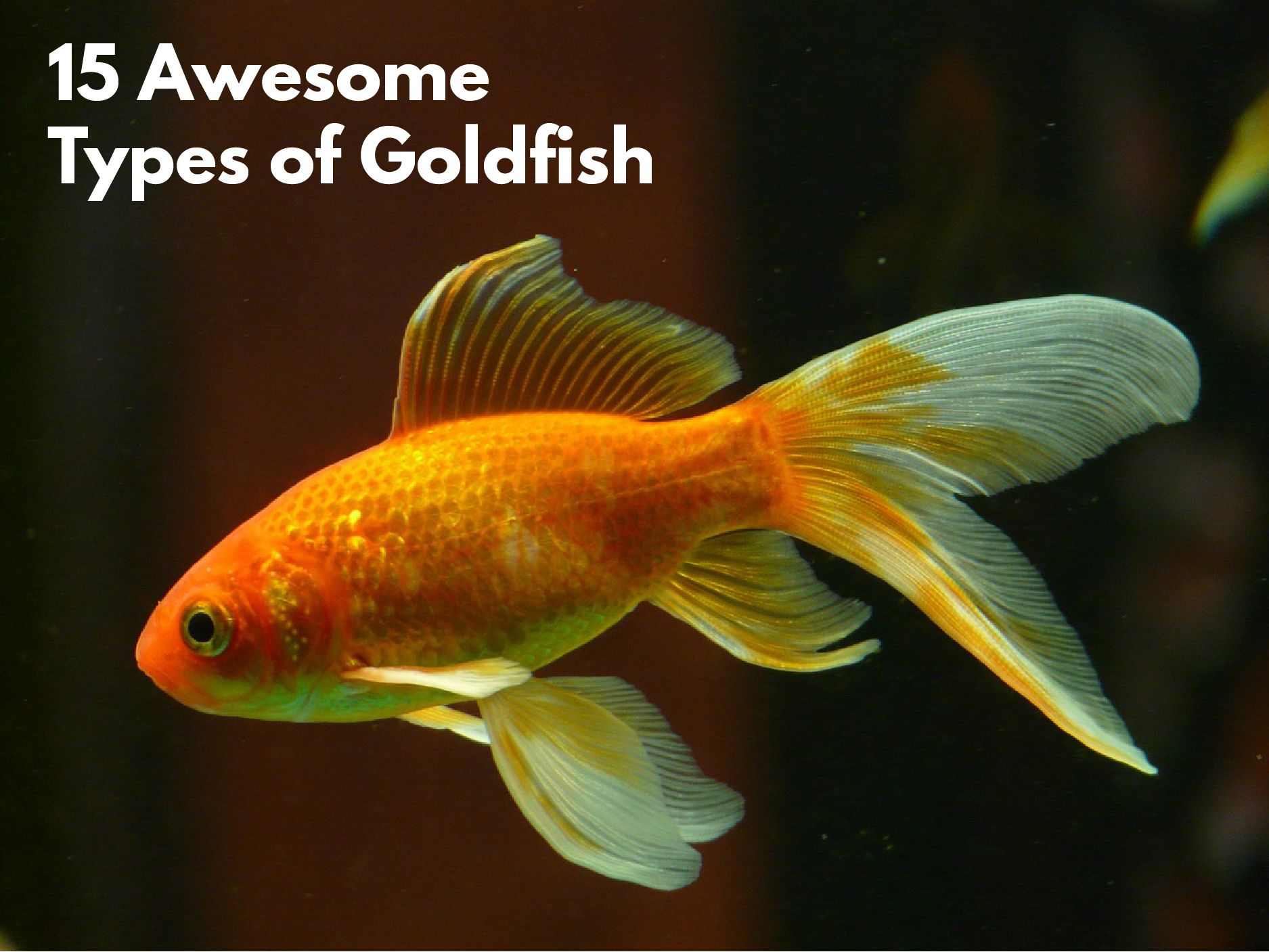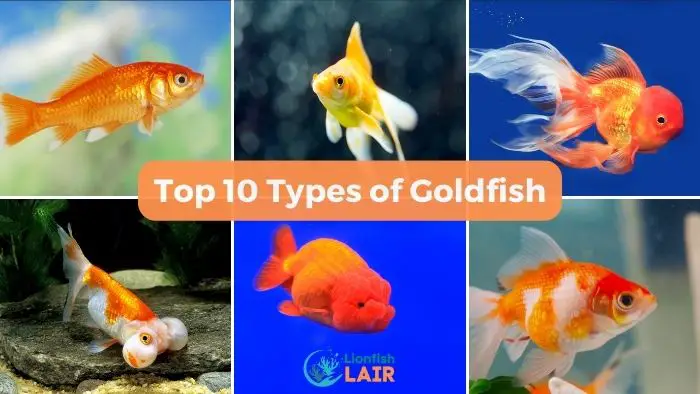Hey there! Have you ever wondered what types of goldfish are out there? We all know goldfish as those cute little fish swimming around in our fish tanks, but did you know that there are actually many different varieties of goldfish? In this article, we will explore some of the most common types of goldfish and learn more about their unique characteristics. So, if you're a goldfish lover or just curious about these beautiful creatures, keep reading because this is going to be interesting!
When it comes to goldfish, there is a wide range of shapes, sizes, and colors to choose from. From the classic orange and white Comet goldfish to the striking black and red Ryukin goldfish, there is a goldfish for everyone's taste. And let's not forget about the majestic and elegant Butterfly goldfish or the charming and fancy Orandas. Each type of goldfish has its own distinct features, from long flowing fins to unique body shapes. It's truly fascinating how these fish can come in so many different varieties!
In this article, we will delve into the characteristics of each type of goldfish in more detail, exploring their origins, physical traits, and specific care requirements. Whether you're interested in starting your own goldfish collection or simply curious about these incredible creatures, by the end of this article, you'll have a wealth of knowledge about the different types of goldfish out there. So, get ready to dive into the wonderful world of goldfish - trust me, you won't be disappointed!
What Types Of Goldfish Are There
Goldfish are a popular choice for aquarium enthusiasts, thanks to their vibrant colors and graceful swimming. But did you know that there are various types of goldfish that differ in appearance and characteristics? In this article, we will explore the different kinds of goldfish, their physical features, care requirements, and recommendations for each type.

This image is property of www.acaquarium.com.
Common Goldfish
Description
The common goldfish, also known as the American or London shubunkin, is the most recognizable type of goldfish. This classic goldfish has a long, torpedo-shaped body with a single tail fin. Common goldfish come in various colors, including orange, red, and white, with some displaying a metallic sheen.
Physical Features
Common goldfish have a long body that can grow up to 14 inches in length. They have a single dorsal fin and anal fin, along with paired pectoral and pelvic fins. These goldfish have a rounded head and eyes positioned on either side. They do not have any distinctive features such as wen or telescope eyes.
Habitat and Care
Common goldfish can be kept in both indoor aquariums and outdoor ponds. They are hardy and can tolerate a wide range of water conditions. It is important to provide them with ample swimming space and a well-filtered environment. They are known to produce a lot of waste, so regular water changes are necessary to maintain water quality.
Recommended For
The common goldfish is an ideal choice for beginners in the world of goldfish keeping. They are relatively easy to care for and can adapt well to different environments. Their vibrant colors and graceful swimming make them a joy to watch.
Conclusion
The common goldfish is a classic choice for goldfish enthusiasts. With its vibrant colors and sleek body, it adds a touch of elegance to any aquarium or pond. Its hardy nature and adaptability make it a popular choice for beginners. Whether you choose to keep them indoors or in an outdoor pond, the common goldfish will provide endless hours of enjoyment.
Comet Goldfish
Description
The comet goldfish is another well-known type of goldfish. It is very similar in appearance to the common goldfish, with a long and slender body. However, comet goldfish have a longer and more deeply forked tail fin, giving them a comet-like appearance.
Physical Features
Comet goldfish have a streamlined body that can reach lengths of up to 12 inches. They have a single caudal fin that is deeply forked in the shape of a comet. Their heads are more pointed compared to the rounded heads of common goldfish. Like the common goldfish, comet goldfish come in a variety of colors, including orange and red.
Habitat and Care
Comet goldfish can be kept in both indoor aquariums and outdoor ponds, but they thrive best in ponds with ample space to swim. They are hardy and can tolerate a wide range of water conditions. However, like all goldfish, they require clean and well-filtered water. Regular water changes and proper filtration are necessary to maintain their health.
Recommended For
Comet goldfish are recommended for those who have experience in goldfish keeping. They are active swimmers and require plenty of space to thrive. Their long and graceful bodies make them a beautiful addition to larger aquariums or ponds.
Conclusion
The comet goldfish is a stunning addition to any goldfish collection. With its comet-like tail fin and vibrant colors, it is sure to catch the eye of any observer. While it requires more space compared to the common goldfish, the effort is well worth it for the beauty and elegance that the comet goldfish brings.

This image is property of petkeen.com.
Shubunkin Goldfish
Description
The shubunkin goldfish is known for its striking calico pattern, reminiscent of watercolor paintings. Its body is elongated and similar in shape to the common goldfish, with a single tail fin.
Physical Features
Shubunkin goldfish have elongated bodies that can reach lengths of up to 10 inches. They have a single tail fin and fins on their dorsal, anal, pectoral, and pelvic regions. What sets shubunkin goldfish apart is their calico pattern, which consists of a mix of orange, red, black, and blue markings.
Habitat and Care
Shubunkin goldfish can be kept in both indoor aquariums and outdoor ponds. They are hardy and can tolerate a wide range of water conditions. However, they are prone to getting chilled, so it is important to provide them with ample space and proper heating in colder climates. Regular water changes and a well-filtered environment are necessary for their well-being.
Recommended For
Shubunkin goldfish are recommended for those who appreciate the beauty of the calico pattern. Their vibrant colors and unique markings make them stand out in any aquarium or pond. They are also a great choice for those living in colder climates, as they can tolerate lower temperatures compared to other goldfish types.
Conclusion
The shubunkin goldfish is truly a work of art. With its mesmerizing calico pattern, it adds a touch of elegance and beauty to any aquatic environment. Whether you choose to keep them indoors or in an outdoor pond, the shubunkin goldfish is sure to captivate you with its unique colors and graceful swimming.
Fantail Goldfish
Description
The fantail goldfish is known for its double tail fin, which gives it a fan-like appearance. Its body is short and round, with a broad and deep tail root.
Physical Features
Fantail goldfish have a short and rounded body that can reach lengths of up to 8 inches. They have a double tail fin, meaning they have two lobes instead of a single fin. The fantail's tail fin is often spread out in a fan-like shape. They come in various colors, including orange, red, white, and black.
Habitat and Care
Fantail goldfish can be kept in both indoor aquariums and outdoor ponds. They require ample swimming space and a well-filtered environment. It is important to provide them with a soft substrate, as their delicate fins and tails are prone to damage. Like all goldfish, regular water changes and proper filtration are necessary for their well-being.
Recommended For
Fantail goldfish are recommended for those who appreciate the beauty of double-tailed goldfish. With their fan-like tails and vibrant colors, they are a stunning addition to any goldfish collection. Their short and rounded bodies make them well-suited for smaller aquariums.
Conclusion
The fantail goldfish is a true gem in the world of goldfish keeping. Its double tail fin and vibrant colors make it a show-stopper in any aquarium or pond. Whether you are a beginner or an experienced enthusiast, the fantail goldfish is sure to bring delight with its unique appearance and graceful swimming.

This image is property of www.buildyouraquarium.com.
Black Moor Goldfish
Description
The black moor goldfish is known for its velvety black color and protruding telescope eyes. Its body is short and rounded, similar to the fantail goldfish.
Physical Features
Black moor goldfish have a short and rounded body that can reach lengths of up to 6 inches. They have a double tail fin similar to the fantail goldfish. However, what sets them apart is their deep black coloration and protruding telescope eyes. The telescope eyes give them a distinctive and almost comical appearance.
Habitat and Care
Black moor goldfish can be kept in both indoor aquariums and outdoor ponds. They require ample swimming space and a well-filtered environment. It is important to provide them with a soft substrate, as their delicate telescoping eyes are prone to damage. Regular water changes and proper filtration are necessary to keep their environment clean and healthy.
Recommended For
Black moor goldfish are recommended for those who appreciate unique and quirky-looking fish. Their black coloration and telescope eyes make them an interesting addition to any goldfish collection. They are also well-suited for smaller aquariums due to their short and rounded bodies.
Conclusion
The black moor goldfish is a charming and fascinating fish to observe. Its velvety black color and protruding telescope eyes make it stand out among other goldfish. Whether you choose to keep them in an indoor aquarium or an outdoor pond, the black moor goldfish is sure to captivate you with its unusual appearance and antics.
Oranda Goldfish
Description
The oranda goldfish is known for its prominent wen, which is a fleshy growth on its head. Its body is short and rounded, similar to the fantail and black moor goldfish.
Physical Features
Oranda goldfish have a short and rounded body that can reach lengths of up to 8 inches. They have a double tail fin similar to the fantail and black moor goldfish. What sets them apart is the wen, a growth on their head that covers their forehead and sometimes extends to their gills. Oranda goldfish come in various colors, including red, orange, blue, and calico.
Habitat and Care
Oranda goldfish can be kept in both indoor aquariums and outdoor ponds. They require ample swimming space and a well-filtered environment. It is important to note that the wen on their head is prone to infections and requires careful maintenance. Regular water changes and proper filtration are essential for their well-being.
Recommended For
Oranda goldfish are recommended for those who appreciate the unique and regal appearance of fish with a prominent wen. Their rounded bodies, double tail fins, and wens make them a true standout in any aquatic environment. Due to their delicate wen, they are best suited for experienced goldfish keepers.
Conclusion
The oranda goldfish is a true crown jewel in the world of goldfish keeping. Its unique combination of rounded body, double tail fin, and prominent wen make it a regal and awe-inspiring fish. Whether you choose to keep them indoors or in an outdoor pond, the oranda goldfish is sure to amaze you with its beauty and captivating presence.

This image is property of lionfishlair.com.
Ryukin Goldfish
Description
The ryukin goldfish is known for its humpbacked appearance and flowing double tail fin. Its body is short and rounded, similar to the fantail, black moor, and oranda goldfish.
Physical Features
Ryukin goldfish have a short and rounded body that can reach lengths of up to 8 inches. They have a double tail fin similar to the fantail, black moor, and oranda goldfish. What sets them apart is their distinctive hump on the back, which gives them a unique and eye-catching profile. Ryukin goldfish come in various colors, including red, orange, white, and calico.
Habitat and Care
Ryukin goldfish can be kept in both indoor aquariums and outdoor ponds. They require ample swimming space and a well-filtered environment. It is important to provide them with a soft substrate, as their delicate fins and hump are prone to damage. Regular water changes and proper filtration are necessary for their overall well-being.
Recommended For
Ryukin goldfish are recommended for those who appreciate the unique humpbacked profile and flowing double tail fin. Their rounded bodies and distinct hump make them a beautiful addition to any goldfish collection. They are well-suited for larger aquariums and ponds.
Conclusion
The ryukin goldfish is a true standout in the world of goldfish. With its humpbacked profile and flowing double tail fin, it commands attention wherever it swims. Whether you choose to keep them indoors or in an outdoor pond, the ryukin goldfish is sure to captivate you with its unique appearance and elegant swimming.
Telescope Eye Goldfish
Description
The telescope eye goldfish is known for its protruding telescope-like eyes. Its body is short and rounded, similar to the fantail, black moor, oranda, and ryukin goldfish.
Physical Features
Telescope eye goldfish have a short and rounded body that can reach lengths of up to 8 inches. They have a double tail fin similar to the fantail, black moor, oranda, and ryukin goldfish. What sets them apart is their distinctly protruding telescope-like eyes, which can be either paired or telescope-eyed. Telescope eye goldfish come in various colors, including orange, red, and calico.
Habitat and Care
Telescope eye goldfish can be kept in both indoor aquariums and outdoor ponds. They require ample swimming space and a well-filtered environment. It is important to note that their telescope eyes are delicate and prone to damage, so a soft substrate is recommended. Regular water changes and proper filtration are necessary for their overall well-being.
Recommended For
Telescope eye goldfish are recommended for those who appreciate the unique and visually striking appearance of fish with telescope eyes. Their rounded bodies and protruding eyes make them a true spectacle in any goldfish collection. Due to their delicate eyes, they are best suited for experienced goldfish keepers.
Conclusion
The telescope eye goldfish is a rare and fascinating fish to behold. With their protruding telescope-like eyes and rounded bodies, they are a true wonder of nature. Whether you choose to keep them indoors or in an outdoor pond, the telescope eye goldfish is sure to captivate you with its unique appearance and intriguing behavior.

This image is property of i.pinimg.com.
Pearlscale Goldfish
Description
The pearlscale goldfish is known for its pearl-like scales that cover its body. Its body is short and rounded, similar to the fantail, black moor, oranda, ryukin, and telescope eye goldfish.
Physical Features
Pearlscale goldfish have a short and rounded body that can reach lengths of up to 6 inches. They have a double tail fin similar to the fantail, black moor, oranda, ryukin, and telescope eye goldfish. What sets them apart is their distinctive pearl-like scales that cover their body. Pearlscale goldfish come in various colors, including orange, red, white, and calico.
Habitat and Care
Pearlscale goldfish can be kept in both indoor aquariums and outdoor ponds. They require ample swimming space and a well-filtered environment. It is important to note that their delicate pearl-like scales require careful maintenance to prevent damage. Regular water changes and proper filtration are necessary for their overall well-being.
Recommended For
Pearlscale goldfish are recommended for those who appreciate the unique and ornate appearance of fish with pearl-like scales. Their rounded bodies and pearl scales make them a true gem in any goldfish collection. They are best suited for smaller aquariums due to their short and rounded bodies.
Conclusion
The pearlscale goldfish is a true treasure in the world of goldfish keeping. Its pearl-like scales and rounded body make it an extraordinary and beautiful fish. Whether you choose to keep them indoors or in an outdoor pond, the pearlscale goldfish is sure to mesmerize you with its shimmering scales and gentle swimming.
Conclusion
In conclusion, there are countless types of goldfish that vary in appearance, physical features, and care requirements. From the classic common goldfish to the unique pearlscale goldfish, each type offers its own charm and beauty. Whether you are a beginner or an experienced goldfish enthusiast, there is a goldfish type out there that will capture your heart. So why not dive into the world of goldfish keeping and bring some vibrant colors and graceful swimming into your life?










